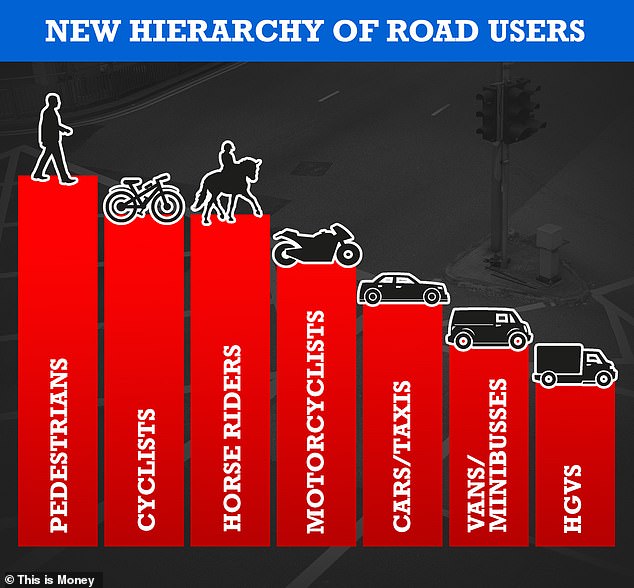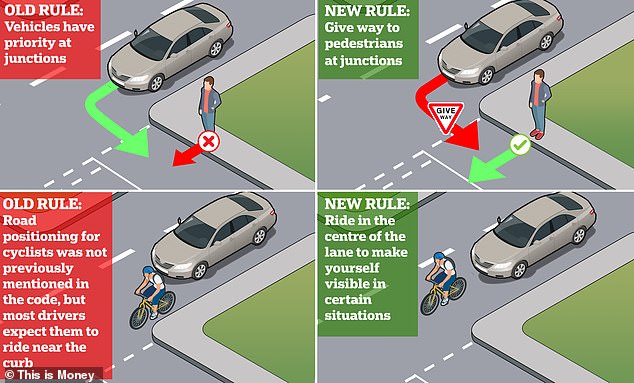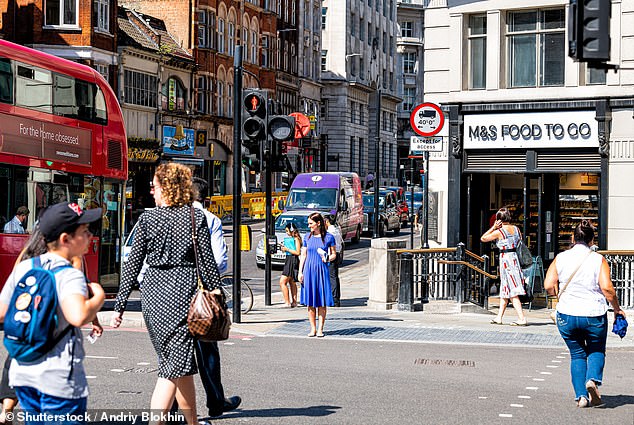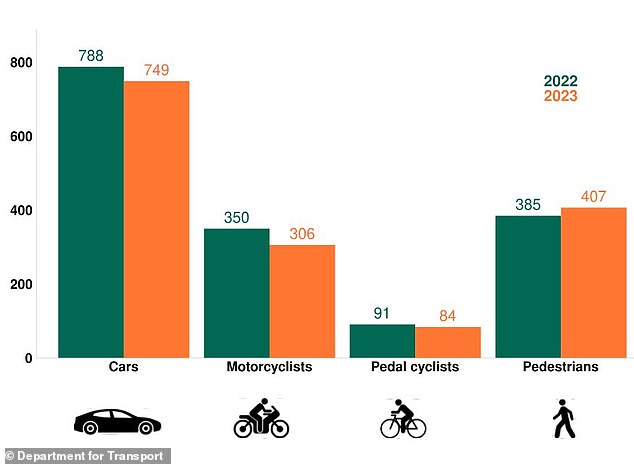Two years after a groundbreaking traffic rule was introduced to protect pedestrians and cyclists, two in five drivers are still ignoring it
A survey has found that a key rule in the Road Traffic Act, introduced two years ago by the Department for Transport to improve road safety, is being ignored by more than two-fifths of drivers.
A poll of almost 10,000 British motorists found that 42 percent were either unaware of the rule or had heard of it but believed it was not true.
The AA wants drivers to be reminded of the rule annually, for example when they receive a notification about the renewal of their motor vehicle tax.
In January 2022, a series of new rules were added to the Road Traffic Act to increase road safety. However, two years later, more than two-fifths of drivers ignore them or are unaware of them
On 29 January 2022, the Road Traffic Act was updated with a catchment area update that included a number of new rules.
The news was largely dominated by the new ‘hierarchy of road users’: a pyramid scheme that means drivers of vehicles that can cause the most damage have the most responsibility for caring for others around them.
In principle, the larger and heavier the vehicle you drive, the more responsibility you have to limit risks.
That means truck, bus and lorry drivers have the most responsibility, followed by van and minibus drivers, then cars and taxis, and then motorcyclists. Cyclists and horse riders also have more responsibility than pedestrians.
The amended traffic regulations contain the following sentence: ‘The hierarchy does not mean that everyone must not behave responsibly.’

The Road User Hierarchy is a pyramid system of protection to keep the most vulnerable safe. Some 42% of UK motorists surveyed said they ignore it when driving
The hierarchy rules include a series of instructions on who has priority when a motorist is turning at an intersection and a pedestrian is crossing the road or waiting to cross.
This states that in all cases the pedestrian has priority over other traffic, including cyclists. Motorists must wait and give the cyclist the opportunity to go to the other side.
But still, disturbingly enough, Thirty percent of executives said they did not know if such a rule existed, while 12 percent believed the rule was false, according to a survey of 9,839 AA members.
When the AA asked the same question in December 2021, a month before the changes were implemented, two-thirds (68 percent) of drivers were unaware of the rules on the ‘hierarchy of responsibility’.
However, other rules introduced at the same time were successfully recalled by motorists.

This graph shows the new rules in the Road Traffic Act to protect both cyclists and pedestrians as part of the road user hierarchy pyramid system for road safety.
About 85 percent of respondents knew that drivers turning left must let cyclists pass on their left before performing the manoeuvre. Two in five knew that drivers must maintain a minimum distance of 1.5 metres when passing cyclists at up to 30 mph (48 km/h), and must give cyclists more space when passing at higher speeds.
However, only half of drivers knew that the updated Code formally mentioned situations where cyclists could ride two abreast in the middle of the lane.
56 percent of drivers wrongly believed that long-standing rules on when the horn cannot be used would be introduced in 2022, while 42 percent believed the national speed limit for towing a trailer or caravan in a single lane would be reduced to 50mph.
Tim Rankin, director of AA Accident Assist, said: ‘While most drivers can remember important changes to the road rules, too many are unaware of the most important change that places greater responsibility on drivers.
‘Three in ten drivers admit they haven’t read the rules of the road since getting their licence. New drivers and those learning to drive will be most aware of the update, but it’s long-time drivers who should be contacted to check they know the rules.
“It is vital that we continue to remind drivers of these changes. They can make our roads safer and reduce the number of accidents.”
Rankin says the AA wants drivers to be reminded of important changes to the road rules annually so they can raise awareness of the latest regulations.
“Every year, millions of drivers are called with reminders for motor vehicle tax and driver’s license renewals,” he said.
“This would be the ideal opportunity to inform everyone about the amended rules and keep the changes in mind.”

Does the Road User Hierarchy Work? Government data shows that a quarter of all road deaths last year were pedestrians – the most vulnerable road users in the pyramid scheme
Does the road user hierarchy work?
Official figures show that the rule changes have done little to improve the safety of the most vulnerable road users: pedestrians.
The Preliminary government statistics on road casualties for 2023 Research has shown that the number of pedestrian deaths on UK roads has risen by 6 per cent compared to last year, from 385 to 407.
They are also 2 percent higher than a decade ago, despite the fact that new cars are equipped with a wealth of innovative technology to prevent pedestrian accidents.
The data also shows that a quarter of all road deaths last year were pedestrians.
However, fewer cyclists were killed last year, even though cyclists are the second most vulnerable group of road users.
The number of deaths fell from 91 to 84 last year, a decrease of 7 percent. Compared to ten years ago, the number of bicycle victims has fallen significantly, by 23 percent.

The government’s provisional road casualty statistics for 2023 show that the number of pedestrian deaths on UK roads has risen by 6% compared to last year, from 385 to 407. However, the number of cyclist fatalities has fallen
When the rules on the hierarchy of road users were introduced in January 2022, it led to angry reactions from some motorists, who felt that cyclists were being given the right to use the road.
In November, the House of Commons Public Accounts Committee warned in a report that news coverage of changes to road traffic regulations was not being communicated effectively enough to encourage public participation.
Earlier this year, the RAC found evidence that drivers were ignoring important rules.
Rod Dennis, road safety spokesman for the motoring group, said: ‘When the major changes to the road rules were first introduced we were very pleased as they were intended to make the roads much safer for the most vulnerable road users.
‘But two years later, it is worrying to see that there is still so much uncertainty. Most drivers do not stop for people crossing when they should, which has not improved the safety of many pedestrians at intersections.’
Dennis added: ‘Part of the reason may be that directors are simply unaware of the changes, and certainly not aware of the consequences of ignoring them.
‘Most drivers probably hardly consult the traffic rules after they get their driver’s license, and that could be the problem.
‘We urge motorists to take a closer look at the changes. This can be done by visiting the websites of the Road Traffic Act or the RAC, or by taking a printed copy with them.
‘We urge the government to make an additional effort to communicate the changes to all road users.’
A DfT spokesman said at the time: ‘All road users should feel confident using our roads, which is why we have ensured that the changes to the road rules were directly informed by a public consultation in which more than 20,000 people took part.
‘To raise awareness of the changes, we have been running our Think! campaign over the past two years to raise awareness and understanding of the changes.’
Some links in this article may be affiliate links. If you click on them, we may earn a small commission. That helps us fund This Is Money and keep it free. We do not write articles to promote products. We do not allow commercial relationships to influence our editorial independence.
